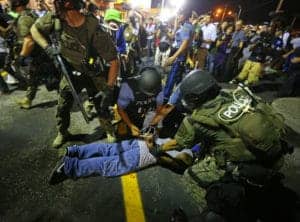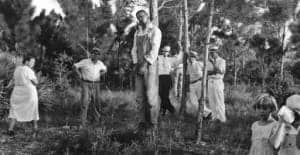by April V. Taylor
Most Americans tend to think of lynchings as a dated form of racial violence that suddenly disappeared with the ending of Jim Crow; however, America’s proclivity towards slaughtering Black people lives on through the country’s police departments. A recent article published by The Guardian illustrates just how true this reality is, revealing that historians estimate that during the late 19th and early 20th centuries, two to three Black people were lynched every week in the American South.

When this is compared with the incomplete data compiled by the FBI that shows that a Black person is killed by a white police officer more than twice a week and studies that reveal that a Black person is killed every 28 hours by police, the stark and gut wrenching reality of the nightmare Americans have never awakened from comes into focus.
Another statistic that brings the grim reality into clearer focus is that fact that white Americans outnumber Black Americans fivefold, but Black people are three times more likely to be killed during an encounter with police. As Isabel Wilkerson points out, there is a haunting symmetry in a Black person being killed every few days that “reminds us that the devaluation of Black life in America is as old as the nation itself and has yet to be confronted.”
The haunting symmetry is not just in the number of dead Black bodies in American streets but also in the stereotypes and images that perpetuate prevailing assumptions of Black inferiority. Instead of Black people being presented as savages and beasts like they once were, the media perpetuates the notion that Black people are gangbangers and thugs.
The psychological impact of the trauma experienced by the Black community when a Black person is killed by the cops is meant to reinforce a racial caste system that is part of the American fabric in much the same way lynchings were. In the same way that a lynched body would be left hanging for days or weeks sometimes to reinforce the lesson that Black people should stay within the racial caste system, Michael Brown’s body was left to bake in the August sun for four hours after he was killed.
Instead of Black people being presented as savages and beasts like they once were, the media perpetuates the notion that Black people are gangbangers and thugs.
A recent Pew study shows that white Americans are disconnected from the reality of Black Americans’ lived experiences today similary to the way they were during Jim Crow. The study found that while 80 percent of Black Americans felt that Michael Brown’s killing raised important concerns about race in America, only 37 percent of whites felt that way.

Just as segregation during Jim Crow kept many white Americans out of touch with the often traumatic Black experience, modern racial isolation and persistent negative stereotypes preclude any chance for the majority of white people to empathize with the Black American experience.
Some may argue that white people do feel empathy for the pain of Black people. However, a study conducted by the University of Milano-Bicocca statistically proved that subconscious bias affects people’s actions so deeply that many times they are unaware of it.
Subjects in the study consistently reacted in a more dramatic, measurable and physiological way when a white person was pierced with a needle than when a Black person was. This subconscious bias is what allows racism to exist and allow people to turn a blind eye to Black pain and Black death.
April V. Taylor can be reached via Twitter @AprilVTaylor.





